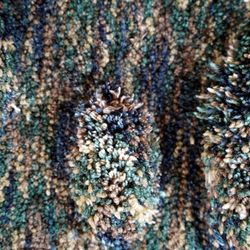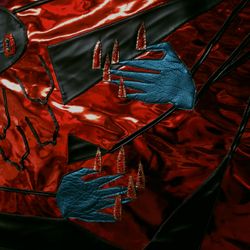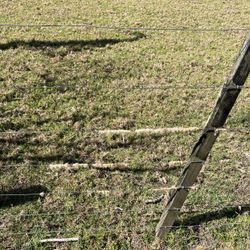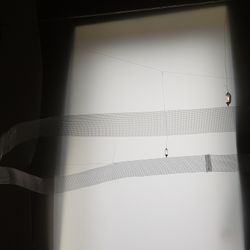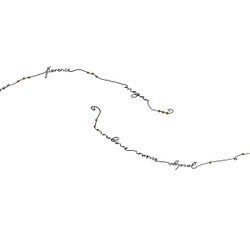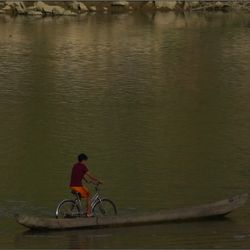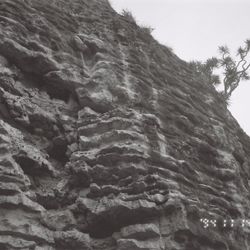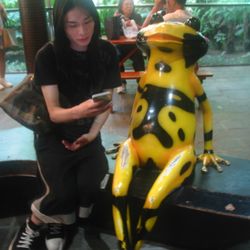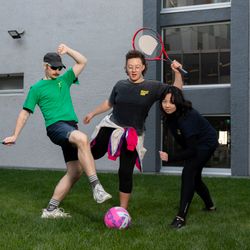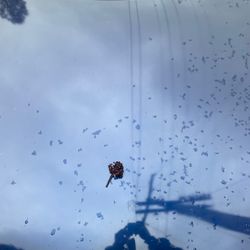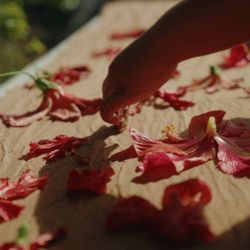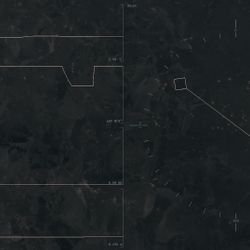Kettle Park is directly behind the sand dunes of St Clair beach and, before it was filled in as a landfill and capped to become a sports field, it was a large lagoon, semi-open to incoming and outgoing ocean tides.
Past Exhibition
Hātarei 21 Hepetema -
Hātarei 26 Oketopa
Saturday 21 September -
Saturday 26 October
2024
Research image courtesy of the artist
Drawn to see(a) brings together artworks by Rozana Lee that trace connections between unfolding environmental catastrophes in two geographically distant places; here, at Kettle Park in South Ōtepoti, and Central Asia, at the former-shoreline of the Aral Sea and in Bishkek, the capital city of Kyrgyzstan. Lee recently spent time in Central Asia on a mobile artist and researcher residency that travelled through Kyrgyzstan, Kazakhstan and Uzbekistan – the region where the Silk Road once passed.
Initially drawn to the region because of its histories of silk and textiles, Lee soon became interested in sites such as the Aral Sea and a landfill on the outskirts of Bishkek. Places where human actions have led to far-reaching environmental issues, with implications far beyond what people anticipated or imagined. In the Aral Sea, now known as the Aralkum Desert, exploitative irrigation projects have led to it rapidly shrinking and becoming hostile to most life forms, with hyper salinity in its pooled remanents and severe problems with toxic, wind-borne dust from areas of the exposed lake basin. The dust’s toxicity stems from contamination with chlorinated pesticides from agricultural runoff and, likely, waste from a chemical warfare plant formerly located on Vozrozhdeniya Island. Nuclear tests were also done on the island.
Similarily, Bishkek landfill is entirely open air and produces large amounts of methane. Smoke from burning within the landfill also produces pollution, and, when it’s hot, an overwhelming stench exudes from it. Polluted water leaching from the landfill threatens to contaminate the nearby Ala-Archa river and groundwater.
The landfill buried under Kettle Park is suspected to hold waste from the decomissioned gasworks of South Ōtepoti; copper, lead, zinc, cyanide, oil, coal tar and asbestos have all been detected in borehole testing, and there is potential for munitions and unexploded ordinances from the former army battery and shooting range at Ocean Beach. Building demolition materials improvised as a shell to protect the landfill are gradually being uncovered and dismantled by the rising sea, and can be found scattered across the sand dunes when walking along the beach.
Lee’s textiles and moving image works draw from each of these sites, and are made through varied processes of collecting materials and note-taking. Whether that be cotton sourced while travelling on the residency, scenes and images taken from each place with a camera, bureaucratic reports and personal written reflections on these sites and direct rubbings on fabric from the physical surfaces of their architectural and environmental features.
The geographical distance between the Aral Sea, Bishkek and the coastline of Ōtepoti seems considerable, although Lee is interested in how they are connected, sometimes in ways which exist out of sight. Networks of trade along the Silk Road linked different places in Central Asia to other ends of the world. Today, the export of waste too from countries like Aotearoa to other regions ties us to these places. Echoes of environmental exploitation, causing climate change and ecosystem collapse, further bind places and peoples, each instance offering a distinct example of a commonly held fate.
Rozana Lee would like to acknowledge all those who contributed to the exhibition: Akbota Saduakassova, Hikoyat Salimova, Hutch Wilco, Bermet Borubaeva, Iskender Aliev and the Leibniz Institute for Regional Geography, Leipzig.
Kā mihi to Akbota and Hikoyat for sharing their writing about the Aral Sea, which can be read below.
Installation view, 2024.
Photo: Miranda Bellamy
Installation view, 2024.
Photo: Miranda Bellamy
Installation view, 2024.
Photo: Miranda Bellamy
Rozana Lee, Luminous grey (still), Single-channel video, text with sound, 10:07 minutes, 2024
Rozana Lee, Trash, smog and coal (still), Single-channel video, text, 6:18 minutes, 2024
Rozana Lee, 26 feet under, Aotearoa merino, machine felted, 2024.
Photo: Miranda Bellamy
Rozana Lee, 26 feet under (detail), Aotearoa merino, machine felted, 2024.
Photo: Miranda Bellamy
Rozana Lee, 26 feet under (detail), Aotearoa merino, machine felted, 2024.
Photo: Miranda Bellamy
Rozana Lee, It's always ourselves we find in the sea (still), Single-channel video, text, 6:25 minutes, 2024
Rozana Lee, It's always ourselves we find in the sea (still), Single-channel video, text, 6:25 minutes, 2024
Installation view, 2024.
Photo: Beth Garey
Rozana Lee, Patience of the stones, Ink stick rubbings on silk georgette, Pacific Ocean sea water, burning, 2024.
Photo: Miranda Bellamy
Rozana Lee, Patience of the stones, Ink stick rubbings on silk georgette, Pacific Ocean sea water, burning, 2024.
Photo: Miranda Bellamy
Rozana Lee, Patience of the stones (detail), Ink stick rubbings on silk georgette, Pacific Ocean sea water, burning, 2024.
Photo: Miranda Bellamy
Rozana Lee, Patience of the stones (detail), Ink stick rubbings on silk georgette, Pacific Ocean sea water, burning, 2024.
Photo: Miranda Bellamy
Installation view, 2024.
Photo: Miranda Bellamy
Rozana Lee, Research images, C-type prints, 2024.
Photo: Miranda Bellamy
Rozana Lee, White gold, Aotearoa merino on Uzbek cotton rag, hand felted, 2024.
Photo: Miranda Bellamy
Rozana Lee, White gold (detail), Aotearoa merino on Uzbek cotton rag, hand felted, 2024.
Photo: Miranda Bellamy
Reading resources for Drawn to see(a).
Photo: Miranda Bellamy
Reading resources for Drawn to see(a).
Photo: Miranda Bellamy
Installation view, 2024.
Photo: Miranda Bellamy
Installation view, 2024.
Photo: Miranda Bellamy
Installation view, 2024.
Photo: Miranda Bellamy
Rozana Lee, Luminous grey (still), Single-channel video, text with sound, 10:07 minutes, 2024
Rozana Lee, Trash, smog and coal (still), Single-channel video, text, 6:18 minutes, 2024
Rozana Lee, 26 feet under, Aotearoa merino, machine felted, 2024.
Photo: Miranda Bellamy
Rozana Lee, 26 feet under (detail), Aotearoa merino, machine felted, 2024.
Photo: Miranda Bellamy
Rozana Lee, 26 feet under (detail), Aotearoa merino, machine felted, 2024.
Photo: Miranda Bellamy
Rozana Lee, It's always ourselves we find in the sea (still), Single-channel video, text, 6:25 minutes, 2024
Rozana Lee, It's always ourselves we find in the sea (still), Single-channel video, text, 6:25 minutes, 2024
Installation view, 2024.
Photo: Beth Garey
Rozana Lee, Patience of the stones, Ink stick rubbings on silk georgette, Pacific Ocean sea water, burning, 2024.
Photo: Miranda Bellamy
Rozana Lee, Patience of the stones, Ink stick rubbings on silk georgette, Pacific Ocean sea water, burning, 2024.
Photo: Miranda Bellamy
Rozana Lee, Patience of the stones (detail), Ink stick rubbings on silk georgette, Pacific Ocean sea water, burning, 2024.
Photo: Miranda Bellamy
Rozana Lee, Patience of the stones (detail), Ink stick rubbings on silk georgette, Pacific Ocean sea water, burning, 2024.
Photo: Miranda Bellamy
Installation view, 2024.
Photo: Miranda Bellamy
Rozana Lee, Research images, C-type prints, 2024.
Photo: Miranda Bellamy
Rozana Lee, White gold, Aotearoa merino on Uzbek cotton rag, hand felted, 2024.
Photo: Miranda Bellamy
Rozana Lee, White gold (detail), Aotearoa merino on Uzbek cotton rag, hand felted, 2024.
Photo: Miranda Bellamy
Reading resources for Drawn to see(a).
Photo: Miranda Bellamy
Reading resources for Drawn to see(a).
Photo: Miranda Bellamy
Rozana Lee is a multidisciplinary artist of Indonesian-Chinese heritage based in Tāmaki Makaurau. She holds an MFA from Elam School of Fine Arts. Her research is centred on the ideas around sense of place, migration, belonging, post-colonial identity and cross-cultural mobility. Working across textile, painting, video and installation, she explores global histories of encounter and exchange that allow for something shared, both within and beyond existing national and geographic boundaries. Recent exhibitions include: Spring is as sweet as shirotsumekusa, Studio Kura (2024), Memory lines, City Gallery Wellington Te Whare Toi (2024) and Sekali pendatang, tetap pendatang, Te Uru (2023). She has also been a research fellow at the Leibniz Institute for Regional Geography, Leipzig (2024) and an artist resident with the Zhelezka Project, Central Asia (2023).
